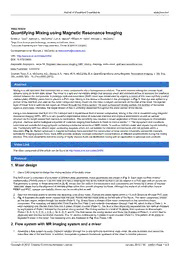
Quantifying Mixing using Magnetic Resonance Imaging. PDF
Preview Quantifying Mixing using Magnetic Resonance Imaging.
JournalofVisualizedExperiments www.jove.com VideoArticle Quantifying Mixing using Magnetic Resonance Imaging EmilioJ. Tozzi1,KathrynL. McCarthy1,LoriA. Bacca2,WilliamH. Hartt2,MichaelJ. McCarthy1 1Dept.FoodScienceandTechnology,UniversityofCalifornia,Davis 2CorporateEngineeringandTechnologyLaboratory,Procter&GambleCompany Correspondenceto:[email protected] URL:http://www.jove.com/video/3493/ DOI:10.3791/3493 Keywords:Biophysics,Issue59,Magneticresonanceimaging,MRI,mixing,rheology,staticmixer,split-and-recombinemix, DatePublished:1/25/2012 Citation:Tozzi, E.J.,McCarthy, K.L.,Bacca, L.A.,Hartt, W.H.,McCarthy, M.J. QuantifyingMixingusingMagneticResonanceImaging.J.Vis.Exp. (59),e3493,DOI:10.3791/3493(2012). Abstract Mixingisaunitoperationthatcombinestwoormorecomponentsintoahomogeneousmixture.Thisworkinvolvesmixingtwoviscousliquid streamsusinganin-linestaticmixer.Themixerisasplit-and-recombinedesignthatemploysshearandextensionalflowtoincreasetheinterfacial contactbetweenthecomponents.Aprototypesplit-and-recombine(SAR)mixerwasconstructedbyaligningaseriesofthinlaser-cutPoly(methyl methacrylate)(PMMA)platesheldinplaceinaPVCpipe.MixinginthisdeviceisillustratedinthephotographinFig.1.Reddyewasaddedtoa portionofthetestfluidandusedastheminorcomponentbeingmixedintothemajor(undyed)component.Attheinletofthemixer,theinjected layeroftracerfluidissplitintotwolayersasitflowsthroughthemixingsection.Oneachsubsequentmixingsection,thenumberofhorizontal layersisduplicated.Ultimately,thesinglestreamofdyeisuniformlydispersedthroughoutthecrosssectionofthedevice. Usinganon-Newtoniantestfluidof0.2%Carbopolandadopedtracerfluidofsimilarcomposition,mixingintheunitisvisualizedusingmagnetic resonanceimaging(MRI).MRIisaverypowerfulexperimentalprobeofmolecularchemicalandphysicalenvironmentaswellassample structureonthelengthscalesfrommicronstocentimeters.Thissensitivityhasresultedinbroadapplicationofthesetechniquestocharacterize physical,chemicaland/orbiologicalpropertiesofmaterialsrangingfromhumanstofoodstoporousmedia1,2.Theequipmentandconditions usedherearesuitableforimagingliquidscontainingsubstantialamountsofNMRmobile1Hsuchasordinarywaterandorganicliquidsincluding oils.TraditionallyMRIhasutilizedsuperconductingmagnetswhicharenotsuitableforindustrialenvironmentsandnotportablewithina laboratory(Fig.2).Recentadvancesinmagnettechnologyhavepermittedtheconstructionoflargevolumeindustriallycompatiblemagnets suitableforimagingprocessflows.Here,MRIprovidesspatiallyresolvedcomponentconcentrationsatdifferentaxiallocationsduringthemixing process.Thisworkdocumentsreal-timemixingofhighlyviscousfluidsviadistributivemixingwithanapplicationtopersonalcareproducts. VideoLink Thevideocomponentofthisarticlecanbefoundathttp://www.jove.com/video/3493/ Protocol 1. Mixer design 1. UseaCADprogramtodesignthemixingsectionsofthestaticmixer. TheSARmixeriscomposedofanumberofdifferentplategeometries;thesegeometriesareshowninFig.3.Eachlaser-cutPoly(methyl methacrylate)(PMMA)plateis1.59mmthickandhasarectangularkeyatthebottomsothatitcanbealignedinaPVCpipewithanacrylicrod. Thegeometryissimilartothosedescribedin[3,4],exceptthatthewallsintheexpansionsandcontractionsareformedbyaseriesofdiscrete “staircase”stepsduetothealignmentofdiscreteplatesratherthansmoothdiagonalsurfaces.Althoughthematerialofconstructionhereis PMMAandPVC,opaquenon-metallicmixerscanbeconstructedaswell. 2. Aligntheindividualplatestodeveloptherepeatingunitsofthemixer.Positiontheplatestightlywithina1½inchSchedule40clearPVCpipe. 3. Fig.4illustratesthestaticmixerviewedfromtheside.Noticethattwofluidsenterattheleftsideofthefigure.Theminorcomponent,shown asthedarkregion,entersthroughthenozzle(PlateS,Fig.3)andformsastreamoftheminorcomponentinthe(colorless)major component.TherepeatingunitstartsafterPlateSatthefirstPlateCandextendsdownstreamthroughPlate48,whichisalsoaPlateC.In eachrepeatingunit,thetwofluidsflowinto8platesofopenchannel(PlateC).Thefluidisthenphysicallyseparatedintotwoverticalchannels byeightplatesofPlateI,followedbytheactualmixingsection.Themixingsectionisatotalof16plates,fromupstreamtodownstream: PlatesI,A,B,D,E,F,G,J,J,K,L,M,N,O,P,andH.Thefluidleavesthemixingsectionandflowsinto8platesofPlateH,inwhichfluidis physicallysplitintotwohorizontalchannels.The“H”sectionisfollowedby8platesofopenchannel(PlateC).Thispatternof48platesis repeated6timesinthemixer.TworepeatingunitsareillustratedinFig.4asPlates1-96. 2. Flow system with MR imaging system and a mixer 1. AssembleaflowsystemtopumpCarbopolsolutionthroughthein-linesplit-and-recombinestaticmixer.Beabletocontrolandrecordthe massflowrateofthetestfluids.Inaddition,incorporateapressuretransducerupstreamofthemixertomonitorpressure. Copyright©2012 CreativeCommonsAttributionLicense January2012| 59 |e3493|Page1of8 JournalofVisualizedExperiments www.jove.com 2. Positionthemixerinthemagnet(Fig.5).Themagnetispartofa1Teslapermanent-magnet-basedimagingspectrometer(AspectImaging, IndustrialAreaHevelModi'in,Shoham,Israel),with0.3T/mpeakgradientstrengthThedimensionsofthemagnetenclosureare700x700x 600mm. 3. DopepartoftheCarbopolsolutionwithmanganesechloride(MnCl2).Thiswillbetheminorcomponent.Themajorcomponentisundoped Carbopolsolution.Fig.6illustratesaschematicofflowsystem. 3. Characterization of the test fluid 1. Preparea0.2%w/wCarbopol(TheLubrizolCorporation)solutionbyslowlysiftingaweighedamountofpolymerintodeionizedwaterina stirredtank.Thispolymerfamilyofproductsisbasedoncrosslinkedacrylicacidchemistryandiswidelyusedinpersonalcareandhousehold productsasrheologicalmodifiers.Neutralizethecarbopolsolutionwitha50%NaOHsolutiontopH7;theneutralizationallowsthesolutionto achieveitsmaximumviscosityasthepolymerswellsinwatertoformagel.PrepareasecondcarbopolsolutioncontainingtheMRcontrast agentMnCl2toafinalconcentrationof0.040mM;thissolutionisreferredtoasthedopedtracerfluid. 2. Characterizetheflowbehavior,orrheology,ofthecarbopolsolutionswithaTAInstrumentsAR-G2rheometer(NewCastle,DE)witha standardCouettegeometry(14mmdiam.x42mmheight)atafluidtemperatureof25°C.Forshearviscosity,useasteadystateshear stresssweepfrom0.1500Painlogarithmicmodewith10points/decadeand5%tolerance.Methodsaredescribedin[5]. Inthiswork,therheologicalpropertiesofthetwosolutionswereindistinguishableandareillustratedinFig.7,datawerefittoapowerlawmodel andshowshearthinningbehavior. Characterizetheviscoelasticpropertiesofthe0.2%w/wcarbopolsolutionwithsmallamplitudeoscillatorytesting.Performthedynamictestingat afixedstressof1Pa,whichcorrespondstothelinearviscoelasticregion.Measurestrainoverafrequencysweepfrom628-0.63rad/s(100-0.10 Hz)inlogarithmicmodewith10points/decade. Thestorageandlossmoduli,G’andG”respectively,areshowninFig.8.ThecurvesarecharacteristicofagelsystemwithG’>G”andG’fairly constant[5].Valuesoftan(δ)=G”/G’increasefrom0.05atlowerfrequenciesto0.3−0.5athigherfrequency.Thecorrespondingphaselag(δ) followedthesametrend,withthelimitsbeingδ=0forHookeansolidsandδ=π/2forNewtonianfluids. 3. EvaluatetherelativecontributionofviscousforcestoinertialforcesduringflowusingtheReynoldsnumber.Sincethecrosssectionofeach platevaries,theaverageflowratethroughtheplateandtheReynoldsnumberiscalculatedandgiveninTable1. TheseReynoldsnumbervaluesaremuchlessthan1.0andcharacterizeflowsinwhichviscousforcesdominatetheinertialforces.Inother words,themixingisbylaminarstretchingandshearingratherthanturbulence. 4. MR data acquisition 1. Selectanappropriateradiofrequencycoil. Thisworkusesasolenoidwithfourturns,encasingacylindricalvolume60mmindiameterand60mmlong.ThiscoilcloselyfitsthePVCpipe andachievedagoodsignal-to-noiseratioofthesignal. 2. Runamulti-slicegradientechosequenceandacquireMRimages. Thispulsesequencewaschosensincethesignalintensityissensitivetomaterialspin-latticerelaxationtime.Therelativesignalintensity betweentwomaterialswithdifferentrelaxationtimesiscalculatedfromanequation.Thesignalintensitydifferences,totalacquisitiontimeforthe imagerelativetotheinfluenceofmoleculardiffusionduringtheimageacquisitionallneedtobeconsideredinselectingtheappropriate experimentalparameters.Additionally,theconcentrationofthecontrastagent(MnCl2)ischosensuchthatthesignalintensitychangesresulting fromcontrastagentconcentrationarelinear.TheadditionofMnCl2decreasesthespin-latticerelaxationtime(T1)ofthetestfluidfrom2.998s (undoped)to0.515s(doped).ThedopedCarbopolsolutionappearsbrighterthantheundopedCarbopolsolutionintheimagessincethe intensityishighlyweightedbythespinlatticerelaxationtime.Thepulsesequenceparametersareanechotime(TE)of2msandarepetitiontime (TR)of30ms;thefieldofview(FOV)is64mmper128encodingswhichyieldsanin-planespatialresolutionof0.5mm/voxel.Withthis multi-slicesequence,weacquire32crosssectionalslicesofthickness1.4mmperimagingslice. 5. Imaging the fluid 1. Pumpboththemajorandminorcomponentsthroughthemixeruntilsteadyflowisachieved.Therelativeflowrateofthemajorandminor componentsis10:1.Simultaneouslystopthepumpsandimagethefluidinthemixer.TheMRsequencedoesnotincludeflowcompensation; toavoidmotionartifacts,theimagingisperformedonquiescentliquid.Imagingtimeisontheorderof1-4minutes. 2. Repositionthemixerseveraltimestoimagecylindricalvolumesatdifferentaxiallocations. Inthisstudy,severalcylindricalvolumesofthemixerareimagedandcanbelocatedinFig.9.Thevolumeischosenbyslidingthemixertube axiallythroughthemagnet,untilthedesiredvolumeisinthesweetspotdefinedbythecenteroftheNMRcoilinthecenterofthemagnet. 3. AnalyzetheMRdatawithimageanalysisprocedurestodocumentthespatialdistributionofcomponentconcentrations.Therelationship betweennormalizedsignalintensity(x)andthefractionofdopedfluid(y)inthisstudyisy=1.419x-0.482(R2=0.99).Thisrelationshipis relevanttoanalyzethemixingprocess.ToillustratethepowerofflowvisualizationusingMRI,thefollowingresultsareselectedimagesat differentaxiallocations. 6. Representative Results Figure10illustratesimagesattheslitnozzle(injector)toshowthecrosssectionsasdopedandundopedenterthefirstrepeatingunit.These imagesalsoclearlyshowthedifferenceinsignalintensitybetween100%dopedfluidandundopedfluid. TheSARmixereffectivelyanduniformlysplitsflowasillustratedintheimagesoftheHPlatesdownstreamfromthe1st,2nd,and3rdmixing sections(Fig.11,firstrow).Thenumberofdopedfluid“stripes”doublethrougheachmixingsection.ThesecondrowofFig.11illustratesthe Copyright©2012 CreativeCommonsAttributionLicense January2012| 59 |e3493|Page2of8 JournalofVisualizedExperiments www.jove.com imageanalysisprocedurethatthresholdstheimagesto“1”s(stripes)and“0”s(everythingelse).Theseprocessedimagesclearlyillustratethe increaseofinterfacialareabetweenthedopedandundopedfluidsasthefluidsplitsandrecombines. SequentialimagesthroughthesecondmixingsectionareshowninFig.12. Table1.Crosssectionalareaofeachplateandaveragevelocitythroughthecrosssection,withcorrespondingReynoldsnumber(Re);defined forapowerlawfluid(PL),usinganequivalentdiameter. Figure1.Photographtoillustrateflowthroughasplit-and-recombinemixerusingCarbopoldyedredastheminorcomponentandundyed Carbopolsolutionasthemajorcomponent. Figure2.2Teslasuperconductingmagnet;forsizereference,theconveyorismoving3avocadosintotheimagingregion. Copyright©2012 CreativeCommonsAttributionLicense January2012| 59 |e3493|Page3of8 JournalofVisualizedExperiments www.jove.com Figure3.PlatetypesandletterdesignationsthatareusedtocreatearepeatingunitintheSARmixer. Figure4.Schematicofthespilt-and-recombinemixer. Copyright©2012 CreativeCommonsAttributionLicense January2012| 59 |e3493|Page4of8 JournalofVisualizedExperiments www.jove.com Figure5.1Teslapermanent-magnet-basedimagingspectrometer(AspectImaging). Figure6.Schematicofflowsystem. Figure7.Apparentviscosityofthe0.2%Carbopolsolution. Copyright©2012 CreativeCommonsAttributionLicense January2012| 59 |e3493|Page5of8 JournalofVisualizedExperiments www.jove.com Figure8.Viscoelasticpropertiesofthe0.2%Carbopolsolution. Figure9.RepeatingunitsoftheSARmixer. Figure10.Twoimagesattheinjector:theupstreamsectionofthenozzlehasacircularcrosssectionforthedopedfluidwhichgradually becomesaslitattheentrancetothefirstrepeatingunitoftheSARmixer. Copyright©2012 CreativeCommonsAttributionLicense January2012| 59 |e3493|Page6of8 JournalofVisualizedExperiments www.jove.com Figure11.Fluiddownstreamoffirst,second,andthirdmixingsections,illustratedatPlateH. Figure12.Sequencesof16sequentialimagesthroughthesecondmixingsection.Pleaseclickheretoseealargerversionoffigure12. Discussion Magneticresonanceimagingisarapidandquantitativemethodforanalysisoffluidmixing.Themeasurementrequiresafewminutestomake andprovidesconcentrationoffluidasafunctionofpositioninthesplit-and-recombinemixer.Thistechniqueissuitableforapplicationtoawide rangeofmixingproblemsandgeometries[6-11].Limitationstothetechniquearethatanonmagneticmixermustbeconstructedandusedinthe MRIequipment,andatleastoneofthematerialsmustprovideasufficientsignalfordataacquisition.AsufficientsignalrequiresanNMRactive nucleiwithasufficientnumberdensity. MRIcanalsobeusedtoquantifymixingofsolidsandliquids,twoliquidswithsignificantlydifferentrheologicalpropertiesaswellasmixingin reactingsystems.ThemixingofsolidsintoaliquidwillyielddifferentimagesthanthoseoftheSARmixer.Inthemixingofsolidsthesolid componentsignaldecaysrapidlyandisnotimaged;hence,thesignalisfromtheliquidonlyandtheconcentrationofsolidisderivedfromthe signallosscomparedtopureliquidsignal. Copyright©2012 CreativeCommonsAttributionLicense January2012| 59 |e3493|Page7of8 JournalofVisualizedExperiments www.jove.com MRImixingimagesprovideanexcellenttestofcomputationalmixingexperiments.Theimagedataprovidesinsightontheimportanceoffluid rheologicalpropertiesanddeviationsfromidealconditions.InFig.12thedeviationsfromideallyuniformlayersoffluidareevident.Theimages obtainedthusprovidedetaileddatasetssuitablefordirectcomparisonwithnumericalpredictionsofcomplexflows. Disclosures AuthorM.McCarthyisaconsultanttoAspectImaging,Ltd.AuthorsL.BaccaandW.HarttareemployeesofProcter&Gamble,Co. Acknowledgements TheauthorswouldliketothankAspectImaging(IndustrialAreaHevelModi'in,Shoham,Israel)forthepulsesequencesusedinthestudy.This workwaspartiallyfundedbyanawardfromtheCenterforProcessAnalyticalChemistryoftheUniversityofWashington(Seattle,WA,USA),as wellasin-kindcontributionsandfinancialsupportfromProcterandGambleCompany. References 1. Callaghan,P.T.PrinciplesofNuclearMagneticResonanceMicroscopy.ClarendonPress,Oxford,(1991). 2. McCarthy,M.J.MagneticResonanceImaginginFoods.Chapman&Hall,NewYork,NY,(1994). 3. Sluijters,R.Mixer.UnitedStatesPatentNo.3182965(1965). 4. vanderHoeven,J.C.,Wimberger-Friedl,R.,&Meijer,H.E.H.Homogeneityofmultilayersproducedwithastaticmixer.Polymer.Eng.Sci.41 (1),32-42(2001). 5. Steffe,J.F.RheologicalMethodsinFoodProcessEngineering.2ndEd.FreemanPress,EastLansing,MI,(1996). 6. Lee,Y.,McCarthy,M.J.,&McCarthy,K.L.Extentofmixinginatwo-componentbatchsystemmeasuredusingMRI.J.Food.Eng.50(3), 167-174(2001). 7. McCarthy,K.L.,Lee,Y.,Green,J.,&McCarthy,M.JMagneticresonanceimagingasasensorsystemformultiphasemixing.AppliedMagnetic Resonance.22(2),213-222(2002). 8. Choi,Y.J.,McCarthy,M.J.,&McCarthy,K.L.MRIforprocessanalysis:Co-rotatingtwinscrewextruder.JournalofProcessAnalytical Chemistry.9(2),72-84(2004). 9. Rees,A.C.,Davidson,J.F.,Dennis,J.S.,Fennell,P.S.,Gladden,L.F.,Hayhurst,A.N.,Mantle,M.D.,Muller,C.R.,&Sederman,A.J.The natureoftheflowjustabovetheperforatedplatedistributorofagas-fluidisedbed,asimagedusingmagneticresonance.ChemicalEng.Sci. 61(18),6002-6015(2006). 10. Stevenson,R.,Harrison,S.T.L.,Mantle,M.D.,Sederman,A.J.,Moraczewski,T.L.,&Johns,M.L.Analysisofpartialsuspensioninstirred mixingcellsusingbothMRIandERT.Chem.Eng.Sci.65,1385-1393(2010). 11. Benson,M.J.,Elkins,C.J.,Mobley,P.D.,Alley,M.T.,&Eaton,J.K.Three-dimensionalconcentrationfieldmeasurementsinamixinglayer usingmagneticresonanceimaging.Exp.Fluids.49,43-55(2010). Copyright©2012 CreativeCommonsAttributionLicense January2012| 59 |e3493|Page8of8
